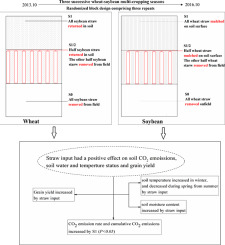Science of the Total Environment ( IF 9.8 ) Pub Date : 2018-10-18 , DOI: 10.1016/j.scitotenv.2018.10.207 Weiyu Wang , Kashif Akhtar , Guangxin Ren , Gaihe Yang , Yongzhong Feng , Liuyan Yuan

|
The use of crop residues as mulching materials or organic fertilizer, instead of burning, can help improve the soil organic carbon (SOC) and crop grain yield. An experiment was conducted for three consecutive seasons from 2013 to 2016, to study the effect of no straw (S0), S1/2 (700 kg/ha soybean straw, and 3000 kg/ha wheat straw), and S1 (1400 kg ha−1 soybean straw, and 6000 kg/ha wheat straw) treatments in wheat-soybean multi-crop system. The randomized complete block design was used with three repeats. Compared with the S0 regime, a significant increase of 0.5%–8.7% and 1.4%–27.7% in soil CO2 emission was observed in the S1 regime during all growth stages of summer soybean and winter wheat, respectively. Soil temperature of S1/2 and S1 was 0.1–1.1 °C and 0.3–1.4 °C higher than that of S0 during the seeding stage and greening stage for wheat, during 2013 to 2016. During wheat season, soil moisture was higher in the S1 than in the S0 treatment. Likewise, wheat, soybean crop resulted the same results. Soil CO2 emissions increase with the increasing in soil temperature, and 73.4–73.9% of the variation could be explained by seasonal variation in soil temperature in wheat season. Similarly, 69.5–74.7% of the variation in soil CO2 emissions is recorded by seasonal variation in soil temperature in summer soybean season. Meanwhile (S1) increased the SOC and grain yield of wheat and soybean when compared to S0. Straw input increasing soil CO2, grain yield and SOC content, considering the benefits of straw inputs to crops yield and SOC content, It is concluded that the addition of straw improve agriculture production. However, the types of straw inputs in order to promote the sequestration of soil organic carbon with the decrease in greenhouse gas emission is the future research direction for agriculture development in Guanzhong region of China.
中文翻译:

半干旱地区秸秆还田对季节性土壤二氧化碳排放,土壤含水量和温度的影响
使用农作物残余物作为覆盖材料或有机肥料,而不是燃烧,可以帮助提高土壤有机碳(SOC)和农作物的产量。从2013年至2016年连续三个季节进行了一项实验,以研究无秸秆(S0),S1 / 2(700千克/公顷的大豆秸秆和3000千克/公顷的小麦秸秆)和S1(1400千克公顷/公顷)的影响在小麦-大豆多作系统中处理−1大豆秸秆和6000 kg / ha小麦秸秆。随机完整区组设计用于三个重复。与S0模式相比,土壤CO 2显着增加了0.5%–8.7%和1.4%–27.7%在夏季大豆和冬小麦的所有生长阶段,在S1模式下均观察到排放。在2013年至2016年期间,小麦的播种期和绿化期,S1 / 2和S1的土壤温度分别比S0高0.1–1.1°C和0.3–1.4°C。 S1比在S0处理。同样,小麦,大豆作物也获得了相同的结果。土壤CO 2排放随着土壤温度的升高而增加,其中73.4%至73.9%的变化可以用小麦季节土壤温度的季节性变化来解释。同样,土壤CO 2变化的69.5–74.7%夏季大豆季节土壤温度的季节性变化记录了温室气体的排放。同时(S1)与S0相比增加了小麦和大豆的SOC和谷物产量。秸秆输入增加了土壤CO 2,谷物产量和SOC含量,考虑到秸秆输入对作物产量和SOC含量的有利影响,结论是秸秆的添加提高了农业生产。然而,随着温室气体排放量的减少,以促进土壤有机碳固存的秸秆投入类型是关中地区农业发展的未来研究方向。



























 京公网安备 11010802027423号
京公网安备 11010802027423号